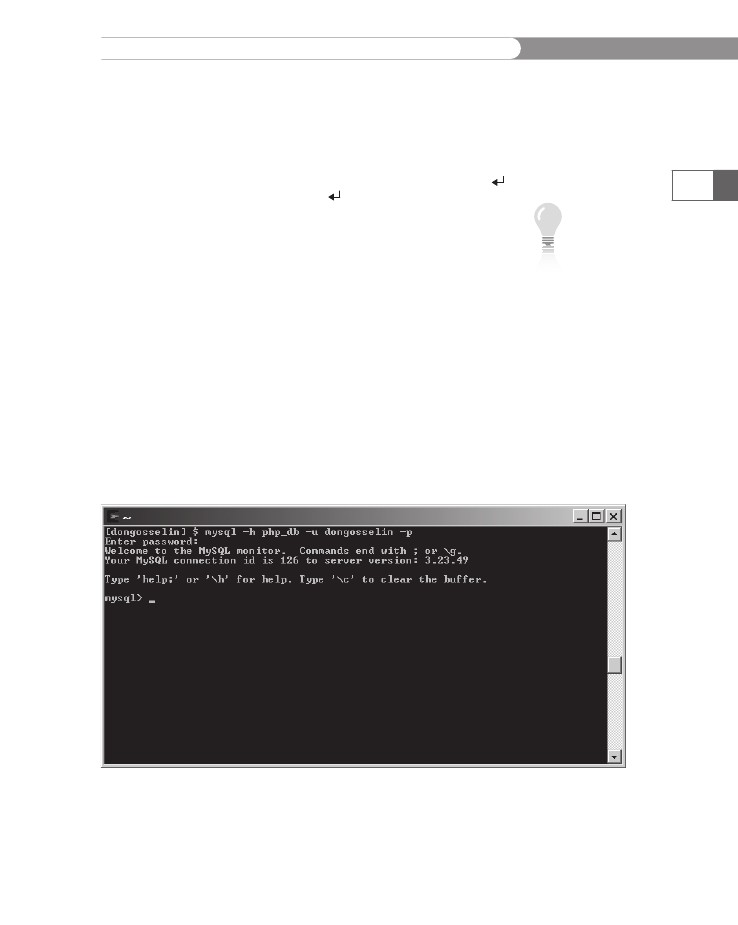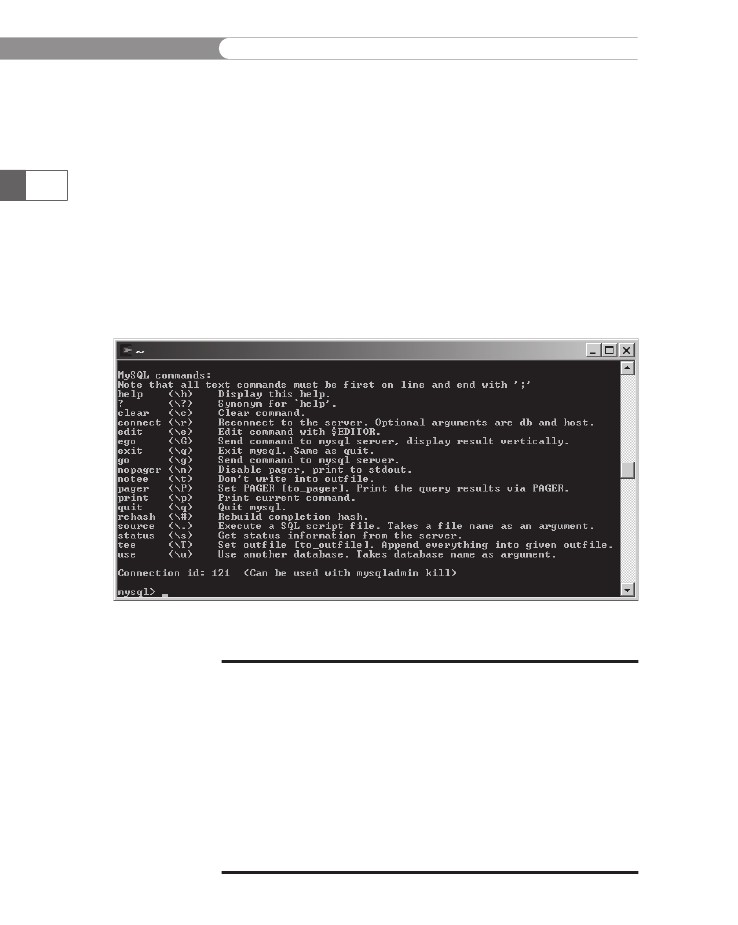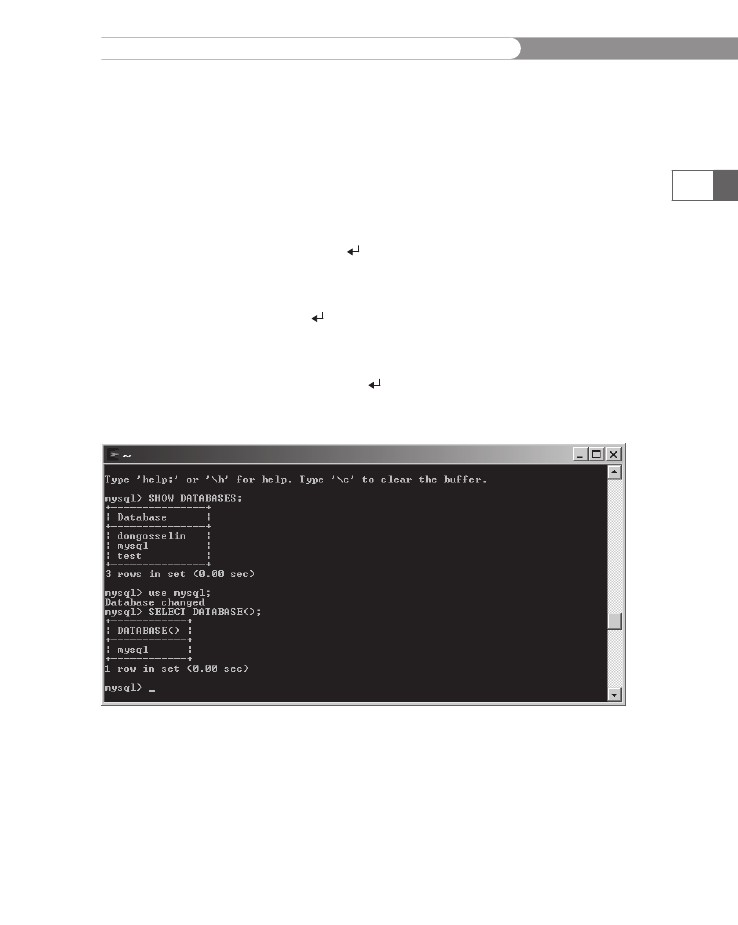
- •Initializing with Constructor Functions . . . . .
- •Into a Web page as a separate section. Although JavaScript code can
- •Is that standard php script delimiters are guaranteed to be available
- •In the block. Any text or lines between the opening /* characters and
- •2.7541 Are not integers; they are floating-point numbers. A floating-
- •Value 300
- •Is a value of 2.5, because 6 goes into 15 exactly 2.5 times. But if you
- •IsEven.Php.
- •Ing example,
- •Ing curly brace is on its own line following the function statements.
- •In php 3 and earlier, it was necessary to put a function definition
- •Is called an iteration. When the conditional expression evaluates
- •Including Files
- •13. Close your Web browser window.
- •Including Files
- •In php, you can also use two operators to combine strings. The first
- •Xhtml source code gen-
- •Input. Php provides several functions for manipulating the case of a
- •Is uppercase. If you need the reverse of ucfirst(), the lcfirst()
- •In some situations, you will need to find and extract characters and
- •Information Interchange, or ascii, which are numeric represen-
- •In comparison, the following preg_match() function returns a value
- •In the pattern is optional. The following code demonstrates how to
- •Values; any strings you validate against a regular expression must
- •Value of 1 because the top-level domain contains a valid value of .Com.
- •Is submitted using the “post” method, the form data is embedded in
- •Validating String Data
- •Xhtml tags or character entities. The message field is a text string
- •Value of the header element. For example:
- •Xhtml code within a php script section.
- •Is typically the person who created the resource. Otherwise, the net-
- •If even a single character of the Web page is sent prior to sending
- •Variables to the file_put_contents() function.
- •Xhtml hyperlink. To download a file from outside the xhtml
- •If...Else statement to display the appropriate version of the mes-
- •Iterating Through an Array
- •Iterating Through an Array
- •In Chapter 2, you learned how to use a foreach statement to iterate
- •Iterating Through an Array
- •Iterating Through an Array
- •In comparison, the following code declares and initializes
- •If ((!file_exists("MessageBoard/messages.Txt"))
- •Values from the array to create a thumbnail gallery of images in which
- •Introduction to Databases
- •Including php, allow you to create Web pages that can read and write
- •Introduction to Databases
- •Information that can be organized into ordered sets of data, and
- •Information. Each recipe in a recipe database, for instance, is a single
- •Introduction to Databases
- •Index, which identifies records in a database to make retrievals and
- •In a single table. However, you might want to break the information
- •Into multiple tables to better organize it into logical sets. Another
- •Information in one of the tables confidential and accessible only by
- •Is the employee information table from Figure 7-1. The related table
- •Is a payroll table that contains confidential salary and compensation
- •Information. Notice that each table contains an identical number of
- •Introduction to Databases
- •Introduction to Databases
- •In a junction
- •Introduction to Databases
- •In a relational format is called a relational database management
- •Is a standard data manipulation language among many dbmSs.
- •Into the query area at the top of the screen or by dragging tables and
- •It is important to understand that even though many dbmSs sup-
- •Introduction to Databases
- •If you ever
- •Is. In comparison, the bigint data type stores integer values between
- •5 Rows in set (0.00 sec)
- •Int);[enter ]
- •Important, these two tabs can cause you to lose all of the data in the
- •Internet Explorer to export the table, click the Save button in the File
- •Ifies the table being changed and the change to make.
- •It easier for you to write php code that can be used with a variety of
- •Information about queries that match one of the following formats:
- •Various types of actions, depending on the type of query.
- •Include fields for the date and time of the flight, flight number, and
- •In the ChineseZodiac folder and upload the file to the server. Open
- •Including white space,
- •Information on a Web server. When you start a new session, the
- •Introduction to Object-Oriented Programming
- •Introduction to Object-Oriented
- •Variables associated with an object are called properties or attributes.
- •In the Loan object example, a function that calculates the number of
- •Introduction to Object-Oriented Programming
- •Introduction to Object-Oriented Programming
- •Include instances of objects inherit the object’s functionality.
- •In this chapter, you will create the Web site for an online order form
- •In an online store application. The application includes information
- •Ity of building a working online store. Online store classes are very
- •Information and products. The OnlineStore class requires that store
- •Information is stored in a table containing six fields: storeId, name,
- •Information. Instead, the class simply uses session iDs to keep track
- •Variable and function as necessary, without bothering with all this
- •In a class
- •Is developed. Imagine what would happen if Microsoft distributed
- •Ing class is invalid because it does not include an access specifier:
- •If they will not be supported by future xhtml versions or are not
- •Xhtml standards. To review the guide of current w3c css specifi-
- •Information to remind yourself or others of what the code is doing. A
- •Xhtml document to the external style sheet. This link informa-
- •If you select Apache from the WampServer menu and select Service
- •Ing code uses the number_format() function to add comma separa-
- •In data that a user submits to a php script.
- •Value of “On” and the display_startup_errors directive is assigned
- •Instead. By looking at the source code, you could see that the value of
- •Ing engine can even help locate logic errors.
- •In Chapter 8, along with the equivalent mssql_* functions, where
- •Inline styles, 632
- •Xhtml, 620–635 (continued)
an
official standard for the SQL language. In 1991, the X/Open and
SQL
Access Group created a standardized version of SQL known as
the
Common Applications Environment (CAE) SQL draft specifica-
tion.
Even with two major standards available, however, most DBMSs
use
their own version of the SQL language. MySQL corresponds
primarily
to the ANSI SQL standard, although it includes a few of its
own
extensions to the language.
SQL
uses fairly easy-to-understand statements to execute database
commands.
SQL statements are composed of keywords that perform
actions
on a database. Table 7-1 lists several SQL keywords that are
common
to most versions of SQL.
Keyword
DELETE
FROM
INSERT
INTO
ORDER
BY
SELECT
UPDATE
WHEREIntroduction to Databases
If you ever
work directly
with another
DBMS, keep
in mind that
the SQL you learn in this
chapter might not corre-
spond directly to that
DBMS’s version of SQL.
391
Description
Deletes a row from a table
Specifies the tables from which to retrieve or delete records
Inserts a new row into a table
Determines the table into which records should be inserted
Sorts the records returned from a table
Returns information from a table
Saves changes to fields in a record
Specifies the conditions that must be met for records to be
returned from a query
Common SQL keywords
You will
study many
of the basic
SQL key-
words in this
chapter. For in-depth
information on SQL state-
ments supported in
MySQL, refer to the
MySQL Reference Manual
at http://dev.mysql.com/
doc/mysql/en/index.
html.
Table 7-1
The simple SQL statement SELECT * FROM Employees returns all
fields (using the asterisk wildcard) from the Employees table. The fol-
lowing code shows a more complex SQL statement that selects the
last_name and first_name fields from the Employees table if the
record’s city field is equal to “Spencer.” The results are then sorted by
the last_name and first_name fields using the ORDER BY keyword.
Notice that commas separate multiple field names.
SELECT last_name, first_name FROM Employees
WHERE city = "Spencer" ORDER BY last_name, first_name;
Short Quiz
1.
Explain the difference between a flat-file database and a rela-
tional database.
Explain the relationship between a primary key and a foreign
key.
2.

CHAPTER
7
Working
with Databases and MySQL
3.
Before
con-
tinuing with
this chapter,
be sure that
you have
been provided access to
an account on a server
with a MySQL installation,
or that you have followed
the instructions in
Appendix B for installing
and testing one of the
xAMP packages.
MySQL
Monitor will
operate the
same regard-
less of
whether you use an SSH
connection, a telnet con-
nection, or a console
window on the server. For
the remainder of this
chapter, the term “con-
sole window” refers to
the window in which you
enter commands.
Several exam-
ples in this
chapter show
the contents
of a console
window and contain both
displayed text and text
that you enter. To distin-
guish between the two
types of text, the text that
you enter is shown in
bold, even though it won’t
appear in bold in the con-
sole window. Additionally,
the symbol [ENTER ] will
indicate where you need
to press the Enter key.
This symbol does not
actually appear on the
screen.
Describe the role of a junction (linking) table.
How does Open Database Connectivity (ODBC) assist in
database management?
Define the acronym SQL and explain its role in database
manipulation.
4.
392
5.
Getting Started with MySQL
As open source software, MySQL is a logical fit with Apache and
PHP, both of which are also developed as open source software. But
there are other reasons for MySQL’s popularity: It is also fast and
reliable, and it supports other programming languages besides PHP,
including C, C++, and Java. MySQL is also fairly easy to use and
install and is available on a number of different platforms.
There are several ways to interface with a MySQL database server
to access and manage your databases, including MySQL Monitor,
phpMyAdmin, and PHP database functions. The MySQL program
you will primarily use in this chapter is MySQL Monitor, which is
a command-line program for manipulating MySQL databases. You
execute the MySQL Monitor program with the mysql command,
which you run through an SSH connection, a telnet connection, or in
a console window on the server itself. Your instructor should provide
you with the information and tools needed to create a command-line
connection to the MySQL server.
In the next section, you will learn how to log in to MySQL.
Logging in to MySQL
To access or manipulate databases with MySQL programs such as
MySQL Monitor (mysql) or phpMyAdmin, you need to log in to
the MySQL database server. To use MySQL Monitor to log in to the
server, enter the following command:
mysql -h host -u user –p
In the preceding command, the -h argument allows you to specify
the host name where your MySQL database server is installed. The
default value for this argument is localhost, so if you are work-
ing with an instance of a MySQL database server that is installed on
your local computer, you do not need to specify the -h argument
and host name. However, if you are working with a MySQL database

Getting
Started with MySQL
server
on an ISP’s Web site, you need to enter your ISP’s host name.
The
-u
argument
allows you to specify a user account name, and the
-p
switch
prompts you for a password. For example, the following
command
logs the user name dongosselin into MySQL Monitor on a
UNIX
installation of MySQL:
[dongosselin]
$ mysql –h php_db -u dongosselin -p[ENTER ]
Enter
password: **********[ENTER ]
Welcome
to the MySQL monitor. Commands end with ; or \g.
Your
MySQL connection id is 6611 to server version: 4.1.9-nt
Type
'help;' or '\h' for help. Type '\c' to clear the buffer.
mysql>
393
You
are
successfully
logged
in
when
you see
the
mysql>
prompt.
To
log in to MySQL Monitor:
1.
2.
Open
a new console window.
Log
in with the following command. Be sure to replace host
and
user
with
the host name and user name provided by your
ISP
or instructor.
mysql
-h host -u user –p
When
prompted, enter the password provided by your ISP or instruc-
tor.
If you are working on a UNIX platform, your screen should look
like
Figure 7-6.
Figure
7-6
MySQL
Monitor on a UNIX platform
CHAPTER
7
Although
the
screen cap-
tures in this
chapter are
taken from a
UNIX operating system
console window, the
MySQL Monitor portion of
your window should
appear the same regard-
less of which operating
system you use.
Working with Databases and MySQL
394
When you finish working with MySQL Monitor, you can log out and
exit the program by entering either the exit or quit command. You
are successfully logged out when you see “Bye” and your command
prompt is restored to the command line for your operating system.
The following example shows how the command line appears on a
Windows installation of MySQL:
mysql> exit[ENTER ]
Bye
[dongosselin] $
To log out of MySQL Monitor:
1.
2.
Return to MySQL Monitor.
Type exit or quit and press Enter. You should see “Bye”
printed to the screen and the command prompt restored to
the command line for your operating system.
Working with MySQL Monitor
The mysql> command prompt in MySQL Monitor is where most
of the action occurs when you create or manipulate databases in
MySQL. If you are familiar with graphical database management
systems, such as Microsoft Access, you might need some time to get
used to the mysql> command prompt. However, keep in mind that
most database management systems, including Access, use SQL to
manipulate databases. MySQL just removes the graphical “front end”
and allows you to enter SQL commands directly. After you become
familiar with working in MySQL Monitor, you may find that you
prefer manipulating databases with the mysql> command prompt
over using a graphical DBMS because you have more precise con-
trol over your database. You may also find that a graphical front end
might not always be available for the database that you need to use,
so your only option is to use a command-line utility. It’s also worth
repeating that you must understand how to write SQL commands
manually to access MySQL databases from PHP scripts, as you do in
the next chapter.
When you enter a SQL command at the mysql> command prompt,
you must terminate the command with a semicolon. For example, the
following SQL statement lists all of the databases currently defined
for your user name:

Getting
Started with MySQL
MYSQL>
SHOW DATABASES;[ENTER ]
+-------------+
|
Database|
+-------------+
|
dongosselin |
|
mysql|
|
test|
+-------------+
3
rows in set (0.00 sec)
mysql>
You
can use
the up and
down arrow
keys on the
keyboard to
scroll back through previ-
ously entered commands.
Once the command is
selected, you can edit it.
Be sure that the cursor is
at the end of the com-
mand before pressing the
Enter key, or anything
after the insertion point
will be ignored.
395
If you omit the ending semicolon when you enter a SQL statement,
MySQL Monitor assumes that you want to enter a multiple-line
command and changes the prompt to ->, which indicates that you
need to enter the next line of the command. For example, the follow-
ing version of the SHOW command does not include the terminating
semicolon. For this reason, the command prompt changes to -> so
that you can enter more statements.
mysql> SHOW DATABASES[ENTER ]
->
To finish executing the preceding statement, just type a semicolon by
itself at the -> command prompt and press Enter.
The SQL keywords you enter in MySQL Monitor are not case
sensitive, so you can enter any of the following statements to list the
databases available to you:
mysql> SHOW databases;[ENTER ]
mysql> show databases;[ENTER ]
mysql> SHOW DATABASES;[ENTER ]
Although you can use any case for SQL keywords, most programmers
follow the convention of using uppercase letters for SQL keywords
and using lowercase or mixed case for the names of databases, tables,
and fields.
Understanding MySQL Identifiers
In MySQL, you must define identifiers (names) for databases, tables,
fields, indexes, and aliases. An alias is an alternate name that you
can use to refer to a table or field in SQL statements. In MySQL, all
identifiers except aliases are limited to 64 characters in length. Aliases
can be up to 255 characters. For database and table names, you can
include any characters that your operating system allows in directory
names and filenames, with the exception of forward slashes (/), back-
slashes (\), and periods (.). Fields, indexes, and aliases can consist of
any characters, including forward slashes, backslashes, and periods.

CHAPTER
7
Working
with Databases and MySQL
Identifiers
in MySQL are quoted using the backtick,
or left single
quote,
character (').
Any identifier may be enclosed in backticks, but
certain
identifiers must be enclosed in backticks. The following list
shows
when an identifier must be quoted.
396
•
An
identifier that includes any character except standard alphanu-
meric characters, underscores (_), or dollar signs ($)
• An identifier that contains one or more space characters
• An identifier that is a reserved word in MySQL
Many other
DBMSs do
not allow
special char-
acters such
as the space in identi-
fiers, nor do they allow
identifiers to start with a
digit. To allow for portabil-
ity across systems, many
programmers specify
identifiers using the most
common naming conven-
tion, which uses a letter
for the first character,
followed only by letters,
numbers, and the under-
score (_) character.
• An identifier made entirely of numeric digits
• An identifier that contains a backtick character
As shown in the preceding list, an identifier must be enclosed in
backtick characters for the identifier to contain a backtick character.
Additionally, the backtick character within the identifier must be
escaped by preceding it with a backtick character. For example, the
identifier don't must be encoded as 'don''t'.
For example, if the first name and last name fields in the
Employees table include spaces, you must use backticks to refer to
the fields. The following statement demonstrates how to return the
first name and last name fields from the Employees table:
mysql> SELECT * 'first name', 'last name' FROM Employees[ENTER ]
-> WHERE city = "Spencer" ORDER BY 'last name', 'first
name';[ENTER ]
Field and
index identi-
fiers are
case insensi-
tive on all
platforms.
Even though SQL keywords are not case sensitive, the case sensitivity
of database and table identifiers depends on your operating system.
MySQL stores each database in a directory of the same name as the
database identifier. Tables are stored in the database directory in files
of the same name as the table identifier. Directory names and file-
names are not case sensitive on Windows platforms, but are case sen-
sitive on UNIX/Linux systems. This means that you do not need to
worry about case sensitivity in database and table names on Windows
platforms, but you do need to observe letter case when referring to
database and table names on UNIX/Linux systems.
Getting Help with MySQL Commands
Most of the commands you enter in MySQL Monitor are SQL com-
mands. However, MySQL Monitor includes additional commands,
such as exit and quit, which are not part of the SQL language. If you
type help; or ? at the MySQL command prompt, you should see sev-
eral support URLs along with the following command descriptions
shown in Table 7-2:

Getting
Started with MySQL
Short
Form
\?
\c
\r
\d
\e
\G
\q
\g
\n
\h
\t
\P
\p
\R
\q
\#
\.
\s
\!
\T
\u
Command
?
clear
connect
delimiter
edit
ego
exit
go
nopager
help
note
pager
print
prompt
quit
rehash
source
status
system
tee
use
Description
Synonym
for “help”
Clear
command
Reconnect
to the server. Optional arguments are db
and
host.
Set
query delimiter
Edit
command with $EDITOR
Send
command to MySQL server and display result vertically
Exit
MySQL. Same as quit.
Send
command to MySQL server
Disable
pager, print to stdout
Display
this help
Don’t
write into outfile
Set
PAGER [to_pager]. Print the query results via PAGER.
Print
current command
Change
your MySQL prompt
Quit
MySQL
Rebuild
completion hash
Execute
a SQL script file. Takes a filename as an argument.
Get
status information from the server
Execute
a system shell command
Set
outfile [to_outfile]. Append everything into given outfile.
Use
another database. Takes database name as argument.
397
Table
7-2
List
of common MySQL commands
Each
of the preceding commands has a long and a short form. The
long
form of each command is not case sensitive, so you can use any
case
you want. (For example, QUIT and Quit are both acceptable.)
However,
for the sake of consistency, you should stick with the letter
cases
that are presented in this book for each command. The short
form
of each command allows you to type a backslash and a single
character
to execute the command. Unlike each command’s long
form,
the short form is case sensitive. To enter the short form of the
quit
command,
for example, you must use \q,
not \Q.
With both the
long
and short forms of each command, you can include a semicolon
to
terminate the line, although it is not required.
The
edit,
nopager,
pager, and
system
commands
are only
available on UNIX/Linux
systems.

CHAPTER
7
Working
with Databases and MySQL
To
log back in to MySQL Monitor and display help for the MySQL
Monitor
commands:
1.
Return
to your console window and log back in to MySQL
with
the root
account,
or with the user name and password
supplied
by your ISP or instructor.
Type
help;
or
?
at
the MySQL command prompt and press
Enter.
You should see a list of MySQL commands, as shown
in
Figure 7-7.
Log
out by typing \q
at
the MySQL command prompt and
pressing
Enter. You should see “Bye” displayed on the screen
and
the command prompt restored to the command line for
your
operating system.
398
2.
3.
Figure
7-7
MySQL
command help
Short
Quiz
1.
2.
3.
What
is the termination character for a SQL statement?
What
SQL command(s) log you out of MySQL Monitor?
Explain
how a multiline SQL statement is structured in
MySQL
Monitor.
How
can you browse through previous SQL commands in
MySQL
Monitor?
4.
Working
with MySQL Databases
Working
with MySQL Databases
This
section explains the basics of working with databases in MySQL.
Creating
Databases
You
use the CREATE
DATABASE statement
to create a new database.
The
following statement creates the vehicle_fleet
database:
mysql>
CREATE DATABASE vehicle_fleet;[ENTER ]
Query
OK, 1 row affected (0.00 sec)
399
If
the database is created successfully, you see the “Query OK”
mes-
sage
shown in the preceding example. If the database already exists,
you
see the following message:
mysql>
CREATE DATABASE vehicle_fleet;[ENTER ]
ERROR
1007: Can't create database 'vehicle_fleet';
database
exists
To
use a specific database, you must select it by executing the
USE
database statement,
as follows:
mysql>
USE vehicle_fleet;[ENTER ]
Database
changed
You
see the “Database changed” message if MySQL successfully
changes
to the specified database. User accounts that do not have
permission
to work with a specified database receive an error mes-
sage
similar to the following:
mysql>
USE vehicle_fleet;[ENTER ]
ERROR
1044: Access denied for user 'dongosselin'@'%' to
database
'vehicle_fleet'
You
will
study how to
manage user
accounts
and permis-
sions later in this chapter.
Creating a new database does not automatically make the new database
the active database. You must follow the CREATE DATABASE command
with a USE database command to use the newly created database.
To verify that you are in the correct database, you use the MySQL
built-in function DATABASE(). The DATABASE() function returns the
name of the currently active database. Unlike PHP, when you call a
function in MySQL, you must use the SELECT keyword before the
function. This tells MySQL to execute the function and return the
result. To verify that you are using the vehicle_fleet database, you
would enter the following:
mysql> SELECT DATABASE();[ENTER ]
Keep in mind that the CREATE DATABASE statement only creates a new
directory for the specified database. Before you can add records to a
new database, you must first define the tables and fields that will store
your data. Later in this chapter, you will learn how to define tables
and fields in a database.

CHAPTER
7
Working
with Databases and MySQL
To
create a new database:
1.
Return
to MySQL Monitor. You should still be logged in from
the
preceding exercise.
Enter
the following command to create the sitevisitors
database:
mysql>
CREATE DATABASE sitevisitors;[ENTER ]
2.
400
3.
After
you see the “Query OK” message, enter the following
command
to select the sitevisitors
database:
mysql>
USE sitevisitors;[ENTER ]
4.
If
you install
a local ver-
sion of
MySQL, two
databases
are installed with it:
mysql and test. The
mysql database con-
tains user accounts and
other information required
for your installation of the
MySQL database server.
The test database
ensures that the data-
base server is working
properly.
After you see the “Database changed” message, type
the following command to ensure that you selected the
sitevisitors database:
mysql> SELECT DATABASE();[ENTER ]
Selecting a Database
To view the databases that are available, use the SHOW DATABASES
statement shown earlier, as follows:
mysql> SHOW DATABASES;[ENTER ]
+---------------+
| Database|
+---------------+
| vehicle_fleet |
+---------------+
1 row in set (0.00 sec)
No database is selected when you first log in to MySQL. To work with
a database, you must first select it by executing the USE database
statement, just as you did after creating the database. For example,
the following statement selects the vehicle_fleet database:
mysql> USE vehicle_fleet;[ENTER ]
Database changed
If you forget which database is selected, you can use the
SELECT DATABASE() statement to display the name of the currently
selected database, as follows:
mysql> SELECT DATABASE();[ENTER ]
+---------------+
| DATABASE()|
+---------------+
| vehicle_fleet |
+---------------+
1 row in set (0.00 sec)
The response from the SELECT DATABASE(); command shows that
you are in the vehicle_fleet database.

Working
with MySQL Databases
To
log back in to MySQL Monitor and select a database:
1.
Return
to your console window and log back in to MySQL
with
the root
account
or with the user name and password
supplied
by your ISP or instructor.
Type
the following command to display the databases that are
available
in your MySQL installation. By default, you should
only
see the mysql
and
test
databases,
although your installa-
tion
might include more.
mysql>
SHOW DATABASES;[ENTER ]
2.
401
3.
Type
the following at the MySQL command prompt to select
the
mysql
database:
mysql>
USE mysql;[ENTER ]
4.
After
you see the “Database changed” message, type the follow-
ing
command to ensure that you selected the mysql
database:
mysql>
SELECT DATABASE();[ENTER ]
Your
screen should look like Figure 7-8.
Figure
7-8
MySQL
Monitor after selecting a database
Deleting
Databases
To
delete a database, you execute the DROP
DATABASE statement,
which
removes all tables from the database and deletes the database
itself.
The syntax for the DROP
DATABASE statement
is as follows:
DROP
DATABASE database;
CHAPTER
7
Although
the
vehicle_
fleet data-
base is
deleted with
this command, it will be
re-created for use with
examples later in this
chapter.
Working with Databases and MySQL
The following statement deletes the vehicle_fleet database:
mysql> DROP DATABASE vehicle_fleet;[ENTER ]
Query OK, 0 rows affected (0.00 sec)
To delete the test database:
1.
2.
402
Return to MySQL Monitor.
Type the following command to ensure that the test database
exists in your MySQL installation:
mysql> SHOW DATABASES;[ENTER ]
You must be
logged in as
the root
user or have
DROP privi-
leges to delete a data-
base. You will study
privileges later in this
chapter.
3.
If you see the test database in the list of available databases,
enter the following command to delete it:
mysql> DROP DATABASE test;[ENTER ]
4.
After you see the “Query OK” message, enter the following com-
mand again to ensure that the test database no longer exists:
mysql> SHOW DATABASES;[ENTER ]
If you are
working with
an instance
of MySQL
that is
hosted by an ISP, the
test database might
have already been
deleted or you might not
have sufficient privileges
to delete databases.
Short Quiz
1.
2.
What statement creates a new directory for a specified database?
What built-in function can be used to return the name of the
active database?
What statement must be executed to change to a specified
database from the active database?
What statement is used to delete a database and any tables it
contains?
3.
4.
Defining Database Tables
This section explains how to select field data types, create tables, and
delete existing tables. Remember that before you can add tables to a
database, you must first create the database, as described earlier in
this chapter.
Specifying Field Data Types
By now, you should thoroughly understand that PHP variables consist
of different data types, which are the specific categories of informa-
tion that a variable can contain. Just like PHP variables, the fields

Defining
Database Tables
in
a table also store data according to type. Recall that one of the
most
important purposes of a variable’s data type is to determine
how
much memory the computer allocates for the data stored in the
variable.
Similarly, the data types in database fields determine how
much
storage space the computer allocates for the data in the data-
base.
MySQL includes numerous data types that are categorized into
numeric
types, string types, and date/time types. Table 7-3 lists some
of
the common MySQL data types.
403
Type
BOOL
TINYINT
SMALLINT
MEDIUMINT
INT
or
INTEGER
BIGINT
FLOAT
Storage
1
byte
1
byte
2
bytes
3
bytes
4
bytes
8
bytes
4
bytes
Range
–128
to 127
–128 to 127
–32,768 to 32,767
–8,388,608 to 8,388,607
–2,147,483,648 to 2,147,483,647
–9,223,372,036,854,775,808 to
9,223,372,036,854,775,807
–3.402823466E+38 to
–1.175494351E-38, 0,
and 1.175494351E-38 to
3.402823466E+38
–1.7976931348623157E+308 to
–2.2250738585072014E-308, 0,
and 2.2250738585072014E-308 to
1.7976931348623157E+308
‘0000-00-00’, ‘1000-01-01’ to
‘9999-12-31’
‘–838:59:59’ to ‘838:59:59’
Fixed-length string between 0 to
255 characters
Variable-length string with a maximum
length between 0 to 65,535
characters
One of a set of predefined strings
Zero or more of a set of predefined
strings, separated by commas
Special information
0 is considered FALSE
0 to 24 bits of precision
DOUBLE or
DOUBLE
PRECISION
DATE
TIME
CHAR (m)
VARCHAR (m)
8 bytes
25-53 bits of precision
3 bytes
3 bytes
Number of bytes
specified by m
Varies up to the
number of bytes
specified by m
Varies
Varies
Maximum length is 255 in
older versions
ENUM
SET
Table 7-3
Common MySQL data types

CHAPTER
7
You
can find
a complete
listing of
MySQL data
types in the
MySQL Reference Manual
at http://dev.mysql.com/
doc/mysql/en/index.html.
Working with Databases and MySQL
404
To store text
in a field,
you specify
a data type
of CHAR(m)
or VARCHAR(m). For
both data types, you
replace m with the maxi-
mum number of charac-
ters you anticipate the
field will store. In general,
you should use the
VARCHAR(m) data type
because the amount of
storage space it occupies
varies according to the
number of characters in
the field.
Be sure you
have exe-
cuted the
USE state-
ment to
select a database before
executing the
CREATE TABLE state-
ment, or you might cre-
ate your new table in the
wrong database.
